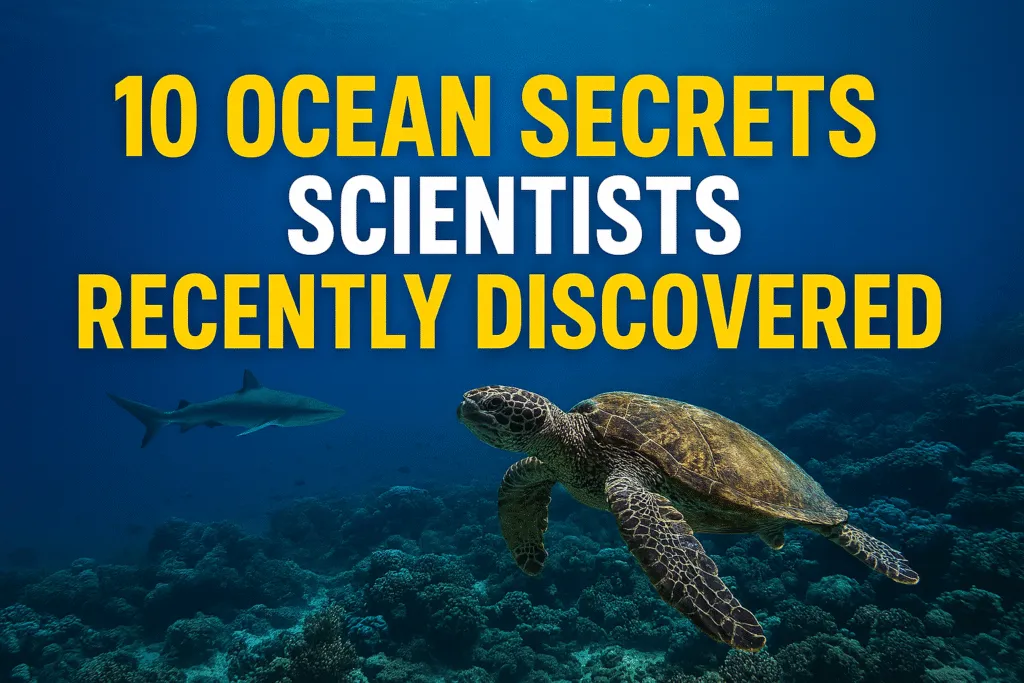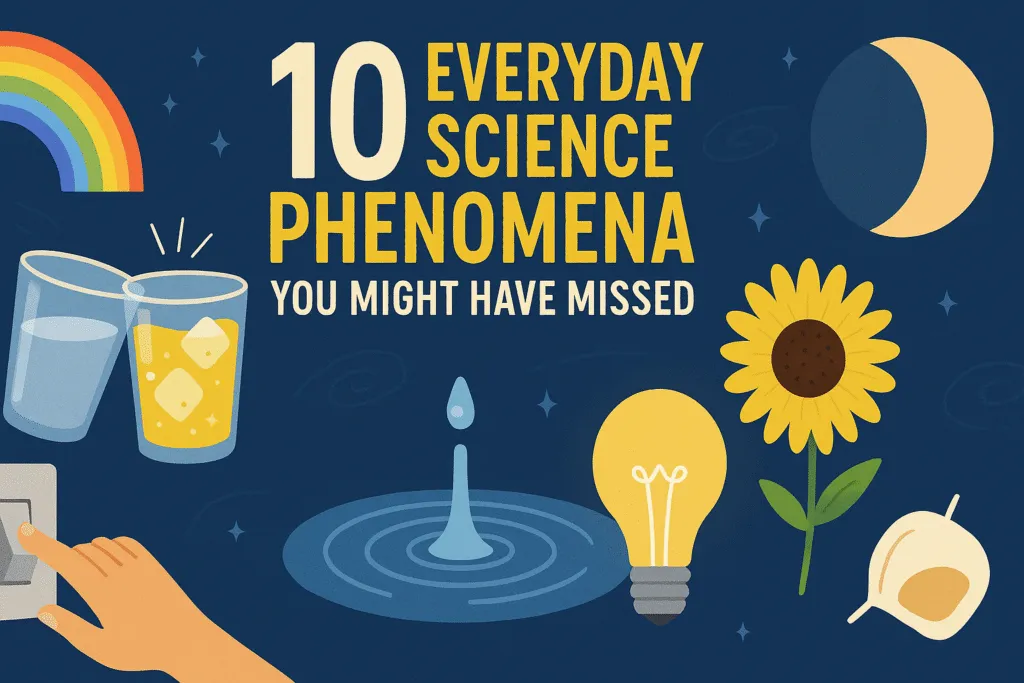Introduction: The Mysterious World Beneath the Waves
The ocean covers more than 70% of our planet, yet we have explored only a fraction of it. Beneath the shimmering surface lies a world full of mystery, beauty, and life forms beyond imagination. For centuries, humans have been drawn to its depth, curious about what lies beyond the reach of sunlight. In recent years, modern technology and advanced research have uncovered fascinating ocean secrets that are reshaping how we understand our planet’s most vital ecosystem. From breathtaking underwater landscapes to never-before-seen marine species, the discoveries are as thrilling as they are important.
The ocean is not just a vast body of water; it is a living, breathing system that influences our climate, supports countless species, and holds resources we are only beginning to understand. Scientists now know that every layer of the ocean has its own unique story to tell. From deep trenches that rival the tallest mountains to hidden currents that control global weather patterns, these ocean secrets highlight just how interconnected our world truly is.
What makes these revelations even more exciting is the role of technology. Sophisticated submarines, remote-operated vehicles, and high-resolution mapping tools are allowing researchers to go where humans have never ventured before. Each journey beneath the waves adds another piece to the puzzle, giving us a better understanding of the ocean’s role in sustaining life on Earth.
The more we learn, the more we realize how much there is still to discover. Every dive, every scan, and every expedition uncovers new marvels that inspire awe and demand protection. Exploring these ocean secrets is not just about satisfying curiosity; it’s about safeguarding the planet’s most precious and powerful environment for generations to come.
A Hidden Ocean Inside the Earth’s Mantle
One of the most astonishing ocean secrets scientists have recently uncovered is that there might be more water hidden deep beneath the Earth’s surface than in all the world’s oceans combined. This “hidden ocean” is not like the blue waters we see on the surface—it exists about 400 miles underground, trapped inside a mineral called ringwoodite. While it’s not in liquid form, the water is bound within the crystal structure of this mineral, creating a vast, unseen reservoir.
This discovery came to light when researchers studying seismic waves noticed something unusual about how they traveled through the mantle. The patterns suggested the presence of water deep within the Earth. Laboratory experiments later confirmed that ringwoodite can hold significant amounts of water, enough to equal or even exceed the volume of the oceans we know today. This finding has profound implications for understanding Earth’s water cycle, suggesting that the planet’s oceans may have originated from deep within rather than from icy comets as once believed.
The idea of a massive water reserve inside the mantle also changes how we think about plate tectonics and volcanic activity. Water stored in this hidden ocean may influence how rocks melt, how continents shift, and how magma moves toward the surface. It could even affect the stability of our planet’s climate over millions of years.
For scientists, this is a reminder that the ocean is not just what we see from the shore—it’s a concept that stretches deep into the planet’s core. This hidden ocean inside the mantle is one of those discoveries that makes us realize just how many ocean secrets are still waiting to be found, even in places we never thought to look.
Glow-in-the-Dark Sharks in the Deep Sea
One of the most mesmerizing ocean secrets scientists have uncovered is the existence of sharks that can glow in the dark. These bioluminescent sharks live in the deep sea, far below the reach of sunlight, where complete darkness is the norm. In these extreme depths, light becomes a powerful survival tool. By producing their own glow, these sharks can blend into their surroundings, communicate, and even lure prey.
Several species have this rare ability, including the blackbelly lanternshark, southern lanternshark, and the kitefin shark. The kitefin shark is especially fascinating—not only because it can glow, but because it’s the largest known bioluminescent vertebrate, growing up to six feet in length. Its light comes from specialized cells called photophores, which are spread across its body and produce a soft, bluish-green glow.
Scientists believe the glow serves multiple purposes. In some cases, it acts as counter-illumination, helping the sharks disappear against the faint light filtering from above, making them nearly invisible to predators and prey. In other instances, the light patterns may serve as signals for finding mates or deterring competitors.
This discovery became possible only through modern deep-sea exploration technology. Remote-operated vehicles and high-sensitivity cameras have allowed researchers to witness these glowing predators in their natural habitat, revealing behavior that had never been documented before.
Glow-in-the-dark sharks are a reminder that even in the most inhospitable environments, life evolves in extraordinary ways. They prove that the ocean still holds countless mysteries waiting to be explored—and each new revelation deepens our respect for the complexity and beauty of marine life.
Giant Underwater Waterfalls You Can’t See
One of the most mind-bending ocean secrets is the existence of massive underwater waterfalls—powerful cascades of water that flow beneath the ocean’s surface, completely hidden from view. Unlike waterfalls on land, these are created when water masses of different temperatures and salinities meet. Colder, saltier water is denser and sinks, while warmer, lighter water rises, creating a continuous downward flow that can be even more powerful than the world’s largest rivers.
The most famous example is the Denmark Strait cataract, located between Greenland and Iceland. Here, cold Arctic water plunges nearly 11,500 feet into the depths of the Atlantic, making it the tallest and one of the most powerful waterfalls on Earth. Despite being invisible to the naked eye, it moves an astonishing 175 million cubic feet of water every second—over 350 times the flow of Niagara Falls.
These underwater waterfalls play a critical role in regulating global ocean circulation. By moving water from one depth to another, they help distribute heat around the planet, influencing weather patterns and climate stability. Without them, the ocean’s “conveyor belt” system would be far less efficient, potentially leading to dramatic shifts in temperatures and ecosystems worldwide.
What makes these hidden giants even more fascinating is that they are not rare—scientists have found similar phenomena in many parts of the world, from the Mediterranean Sea to the Pacific Ocean. Advanced sonar mapping and temperature sensors have been key in revealing their size, strength, and impact.
The idea that some of the planet’s most powerful natural forces are happening silently and invisibly beneath the surface is a powerful reminder of how many ocean secrets remain beyond our daily view, shaping life on Earth in ways we are only beginning to understand.
A New Coral Reef Taller Than the Empire State Building
Among the most exciting ocean secrets in recent years is the discovery of a massive coral reef that stands taller than the Empire State Building. Found off the coast of Australia’s Great Barrier Reef in 2020, this towering structure rises more than 1,600 feet from the seafloor, making it one of the tallest known reef systems on the planet. What’s even more surprising is that it had gone completely unnoticed until advanced underwater mapping technology revealed its size and location.
This newly discovered reef is teeming with life. Divers and researchers found an incredible variety of marine species, from colorful fish and sea turtles to delicate corals thriving in crystal-clear waters. Its unique shape and position allow it to capture sunlight efficiently, supporting vibrant ecosystems at different depths. Scientists believe it may even be home to species not yet documented, adding to its ecological importance.
The reef’s discovery is significant not only for its size but also for what it represents. It shows that despite decades of exploration, large and important parts of our ocean remain hidden. It also highlights the resilience of coral ecosystems, which continue to flourish in some areas despite the widespread damage caused by climate change, pollution, and rising sea temperatures.
Using high-resolution sonar and 3D mapping, scientists were able to study the reef in detail, providing valuable insights into how such massive structures form and evolve. For marine biologists, this is a reminder that the ocean is full of surprises, and that groundbreaking discoveries can still happen in areas we thought we knew well.
This towering coral reef is more than a natural wonder—it’s proof that the ocean holds secrets on a scale we can hardly imagine, waiting to inspire, amaze, and teach us about the delicate balance of life beneath the waves.
The World’s Deepest Fish Ever Recorded
Among the most astonishing ocean secrets recently uncovered is the discovery of the world’s deepest fish ever recorded. In 2023, scientists documented a fish living at an incredible depth of nearly 8,000 meters (around 26,200 feet) in the Mariana Trench—the deepest part of the world’s oceans. This record-breaking find challenges previous assumptions about how deep life can survive in extreme underwater environments.
The fish belongs to a group called snailfish, known for their ability to live in some of the ocean’s most hostile and high-pressure regions. What makes this discovery remarkable is not just the depth but the fish’s unique adaptations that allow it to thrive where sunlight doesn’t reach and pressures are crushing. These adaptations include specialized proteins that protect their cells and flexible bones that withstand the intense pressure.
Before this, scientists believed fish could not survive below about 7,200 meters, but this discovery pushes that limit even further. It opens up new questions about the limits of life on Earth and how organisms evolve to endure conditions that seem impossible. Studying these deep-sea creatures helps researchers understand biological resilience and may even inform fields like medicine and biotechnology.
The expedition that captured this fish used cutting-edge remotely operated vehicles (ROVs) equipped with cameras and sensors, allowing researchers to explore the trench without risking human lives. Every observation adds to a growing body of knowledge about deep-sea ecosystems that remain some of the least explored on the planet.
The world’s deepest fish is a stunning reminder of how much the ocean still hides. It challenges our ideas about life’s boundaries and fuels the ongoing quest to uncover more ocean secrets lying in the darkest depths of our blue planet.
Massive “Blue Carbon” Stores in Seagrass Meadows
One of the most promising ocean secrets scientists have recently uncovered involves “blue carbon” stored in vast seagrass meadows. Blue carbon refers to the carbon captured and stored by marine plants, and seagrass ecosystems play a crucial role in this natural climate solution. These underwater meadows act like carbon sinks, absorbing carbon dioxide from the atmosphere and locking it away in their roots and surrounding sediments for thousands of years.
Seagrass meadows cover less than 0.2% of the ocean floor but are estimated to store nearly 10% of the carbon buried in oceans globally. Recent research has revealed that some of these meadows are much larger and more efficient at carbon storage than previously thought. This discovery is vital because protecting and restoring seagrass habitats could significantly reduce greenhouse gas levels and help combat climate change.
Besides their carbon-storing power, seagrass meadows provide essential habitats for a variety of marine life, including fish, turtles, and endangered species. They also help stabilize the seabed, reduce coastal erosion, and improve water quality. Unfortunately, seagrass ecosystems are threatened by pollution, coastal development, and rising sea temperatures.
Scientists now emphasize the importance of conserving these blue carbon stores as part of global climate strategies. Advanced satellite imaging and underwater drones have allowed researchers to map and monitor seagrass meadows more accurately than ever before, revealing their true scale and potential.
Understanding the role of seagrass in storing blue carbon is one of the ocean secrets that could have a profound impact on how we address climate change. Protecting these vital ecosystems is not just about preserving marine biodiversity—it’s about safeguarding the health of the entire planet.
Underwater Volcanoes Creating New Islands
One of the most dramatic ocean secrets uncovered recently is how underwater volcanoes are constantly shaping our planet by creating new islands. These submarine volcanoes erupt beneath the ocean’s surface, spewing lava, ash, and gases that accumulate over time. When enough material builds up, it can break through the water, forming entirely new landmasses.
A striking example of this process occurred near Tonga in the South Pacific, where a massive underwater volcanic eruption in 2022 gave birth to a new island overnight. Scientists closely monitored the event using satellites and underwater sensors, capturing rare data on how such rapid geological changes take place. These new islands often start as barren rock but quickly become hubs for marine life and, eventually, vegetation if conditions allow.
Underwater volcanoes are vital not only for creating new land but also for supporting unique ecosystems. The heat and minerals they release provide energy and nutrients that sustain life in otherwise nutrient-poor parts of the ocean. Hydrothermal vents formed by volcanic activity host unusual organisms that thrive without sunlight, relying instead on chemical energy.
This natural cycle of destruction and creation is a powerful reminder that the ocean is a dynamic and ever-changing environment. Each volcanic eruption adds to the planet’s geology, influencing ocean currents, marine habitats, and even climate patterns.
Discovering how underwater volcanoes contribute to island formation and ocean ecology is one of the ocean secrets helping scientists better understand Earth’s complex systems. It highlights the ocean’s role as both a cradle of life and a force of constant transformation.
Unexplored Caves with Ancient Marine Life
Deep beneath the ocean floor lie vast networks of underwater caves that remain largely unexplored, hiding some of the ocean’s most intriguing secrets. These submerged caverns are time capsules, preserving ancient marine life and ecosystems that have existed for thousands, sometimes millions, of years. Recent expeditions using advanced diving technology and remotely operated vehicles have started to reveal these hidden worlds, uncovering species and habitats previously unknown to science.
These underwater caves provide refuge for unique creatures adapted to dark, isolated environments. Many species found here have evolved slowly, maintaining traits that have disappeared elsewhere, offering scientists a glimpse into marine life’s distant past. Some caves even contain rare fossils and geological formations that help researchers understand Earth’s climatic and biological history.
The discovery of these caves is important not only for marine biology but also for conservation. As human activity increasingly threatens marine environments, these secluded habitats could be crucial sanctuaries for preserving biodiversity. They also hold clues about how life can survive in extreme conditions, which could have implications for studying life on other planets.
Mapping and exploring these caves is challenging due to their depth, narrow passages, and hazardous conditions. However, recent advancements in underwater robotics and imaging are making it possible to document these mysterious places safely and in great detail.
The secrets held in these unexplored caves remind us that the ocean still holds countless mysteries. Each discovery enriches our understanding of the planet’s history and the resilience of life, highlighting the importance of protecting these hidden underwater worlds.
Ocean Currents Acting Like Global Conveyor Belts
One of the ocean secrets that has gained attention recently is the crucial role ocean currents play as global conveyor belts, moving water, heat, and nutrients across vast distances. These powerful currents regulate the Earth’s climate by transporting warm water from the tropics toward the poles and bringing cold water back toward the equator, helping to maintain a balance that supports diverse ecosystems worldwide.
The most famous of these currents is the Atlantic Meridional Overturning Circulation (AMOC), which includes the Gulf Stream. Scientists have discovered that this system is more sensitive than previously thought, and any significant slowdown could have drastic effects on weather patterns, sea levels, and marine life. Recent studies show changes in current strength linked to melting ice and global warming, raising concerns about future climate stability.
These ocean conveyor belts also distribute nutrients vital for plankton growth—the foundation of the marine food chain. By cycling nutrients and oxygen, currents support fisheries and biodiversity that millions of people depend on for food and livelihoods.
Advanced satellite monitoring and deep-sea sensors have enhanced our understanding of these currents, revealing how interconnected the ocean and atmosphere truly are. The delicate balance maintained by these currents is a reminder of how closely tied our planet’s health is to the secrets hidden beneath the waves.
Understanding how ocean currents act like global conveyor belts helps scientists predict climate changes and emphasizes the need to protect the oceans as part of global environmental efforts. These currents are among the many ocean secrets shaping life on Earth in ways we’re only beginning to grasp.
Microplastics Found in the Deepest Trenches
One of the most alarming ocean secrets uncovered recently is the discovery of microplastics in the deepest trenches of the ocean. These tiny plastic particles, often less than five millimeters in size, have been found even in remote and extreme environments like the Mariana Trench, nearly seven miles below the surface. This shows just how pervasive plastic pollution has become, reaching places once thought untouched by human impact.
Scientists have collected sediment samples from these deep trenches and found microplastics embedded in the seabed, raising serious concerns about the health of deep-sea ecosystems. Marine creatures living in these dark, high-pressure environments are exposed to plastic contamination, which can affect their health, reproduction, and survival. The presence of microplastics in such extreme habitats highlights the far-reaching consequences of plastic waste and the urgent need to address pollution at its source.
This discovery also reveals how plastics break down into smaller and smaller pieces over time, spreading widely through ocean currents and sinking to great depths. Even the most remote parts of the ocean are not safe from human-generated pollution, reminding us that our actions have global impacts.
Efforts to monitor and reduce plastic pollution are more critical than ever. Technologies like deep-sea submersibles and advanced sampling methods have helped scientists understand the scale of the problem, but reversing the damage will require global cooperation and sustainable solutions.
Finding microplastics in the deepest trenches is a sobering ocean secret that underscores the urgency of protecting marine environments. It challenges us to rethink our relationship with plastic and take stronger steps to preserve the health of our planet’s most hidden and vulnerable places.
Why These Discoveries Matter for Our Planet’s Future
The ocean secrets scientists are uncovering are far more than fascinating facts—they hold vital clues about the health and future of our planet. From hidden oceans deep within the Earth to glowing sharks in the darkest depths, each discovery expands our understanding of the complex systems that regulate life on Earth. These findings help us appreciate the ocean’s critical role in maintaining climate balance, supporting biodiversity, and providing resources essential to human survival.
Many of these discoveries highlight how interconnected our world truly is. For example, underwater waterfalls and ocean currents act like massive conveyor belts, distributing heat and nutrients that influence weather patterns and ecosystems globally. Meanwhile, ecosystems like seagrass meadows store enormous amounts of carbon, offering natural solutions to combat climate change.
At the same time, uncovering pollution like microplastics in the deepest trenches reminds us of the profound impact human activity has on even the most remote parts of the planet. It’s a call to action to protect and preserve these fragile environments before irreversible damage occurs.
Understanding these ocean secrets equips scientists, policymakers, and communities with knowledge to make informed decisions. Whether it’s protecting newly discovered reefs, conserving carbon-rich habitats, or regulating plastic use, these discoveries are guiding efforts to create a sustainable future.
Ultimately, exploring and respecting the ocean’s mysteries is essential for the well-being of all life on Earth. By continuing to reveal its secrets, we gain the insight needed to safeguard the planet’s most precious resource and ensure a healthier, more resilient world for generations to come.
Conclusion: The Ocean Still Holds Countless Mysteries
Despite centuries of exploration, the ocean remains one of the least understood parts of our planet. The recent discoveries of ocean secrets—from hidden water reservoirs beneath the Earth’s mantle to glowing sharks and underwater waterfalls—show just how much remains to be uncovered. Each new finding not only deepens our knowledge but also reminds us of the vastness and complexity of marine life and the environments it inhabits.
These mysteries highlight the ocean’s crucial role in regulating climate, supporting biodiversity, and sustaining human life. At the same time, they underscore the urgent need to protect this fragile ecosystem from threats like pollution, climate change, and overfishing. The presence of microplastics in the deepest trenches serves as a stark warning of the far-reaching impact of human activity.
As technology advances, scientists are better equipped than ever to explore the ocean’s depths and reveal its hidden wonders. Yet, for every secret uncovered, countless others remain beneath the waves, waiting to inspire awe and inform conservation efforts.
The ocean’s mysteries are a powerful reminder of nature’s resilience and the ongoing need for responsible stewardship. By continuing to explore, learn, and protect, we can ensure that the ocean remains a source of life, wonder, and discovery for generations to come.
Also Read: Best Cloud Storage: Google Drive vs Dropbox vs Notion 2025.
FAQs: Ocean Secrets and Discoveries
Q1: What are some of the most surprising ocean secrets recently discovered?
Recent discoveries include a hidden ocean inside the Earth’s mantle, glow-in-the-dark sharks, giant underwater waterfalls, massive new coral reefs, and microplastics found in the deepest ocean trenches.
Q2: How do glow-in-the-dark sharks produce their light?
These sharks have special light-producing organs called photophores on their skin, which emit a natural glow to help with camouflage, communication, and hunting in deep, dark waters.
Q3: Why are underwater waterfalls invisible to us?
Underwater waterfalls happen when denser, colder water sinks beneath warmer water, creating powerful currents below the surface that look like waterfalls but are hidden from sight.
Q4: How do seagrass meadows help fight climate change?
Seagrass meadows store “blue carbon,” capturing and locking away carbon dioxide in their roots and sediments for thousands of years, making them crucial natural carbon sinks.
Q5: What impact do microplastics have on deep-sea ecosystems?
Microplastics can harm marine organisms by entering their bodies, causing health issues, and disrupting food chains, even in the deepest and most remote ocean areas.
Q6: How do ocean currents affect global climate?
Ocean currents act like conveyor belts, moving warm and cold water across the globe, which regulates temperatures, weather patterns, and supports marine life worldwide.
Q7: Why is discovering new coral reefs important?
New coral reefs provide habitats for diverse marine species and help scientists understand ecosystem health and resilience, which is vital for conservation efforts.
Q8: How do underwater volcanoes create new islands?
When underwater volcanoes erupt, lava accumulates and can break the ocean’s surface, forming new islands that become habitats for marine and terrestrial life.
Q9: What technologies help scientists explore ocean secrets?
Scientists use remotely operated vehicles (ROVs), submarines, sonar mapping, satellite imaging, and deep-sea sensors to explore and study the ocean’s depths safely and in detail.
Q10: Why is it important to study ocean secrets?
Studying ocean secrets helps us understand Earth’s climate, biodiversity, and ecosystems, guiding efforts to protect the environment and ensure a sustainable future.





























